#cornish western
Text
Hmm… Cornish Western story… hm
#OKAY BUT THIS HAS SOME HISTORICAL VALIDATION#bc okay. in the 1830s there was this MASSIVE Cornish emigration#Cornish tin and copper was drying up and the mining business overall in the uk was coming to its heat death#so boom. no more work for a VAST MAJORITY of Cornish folk#so a lot went to South and Cebtral America and a lot went into the US west and Midwest#because westward expansion was also happening (fuck) and so hey#there’s more work out west and in the Americas#just grass valley Cal. was 3/4 Cornish by descent by 1911#so there was a huge Cornish diaspora group in the American west#there were tons of places labelled as “’little Cornwalls’ all throughout the west#and in mexico too!! real de monte!#that’s the only place I can think of atm that retained the status#now clearly there’s way more nuance to it and a far more complex history#especially when talking abt Manifest Destiny and the suchlike#ik that Cornish miners were being PAID to leave Cornwall for Australia to work but I can’t find anything about anything like that happening#re: immigration to america. it’s an incredibly fascinating history bc it did help out the Cornish economy in ways#still quite a few men went over and sent money back to their families#but anyways. to bastardise an entire period in history#cornish western#(multigenerational story? classic revenge ie escaping a past?)#I should be banned from thinking I don’t do anything good with this ability#its actually an idea I’ve had for a while but only in vague shapes#I just think Cornwall is pretty and I’m deep in its history. I also think the American west is pretty and I’m fascinated by ITS history#kicking a tin can around in my brain with my hands in my pockets#anyways
5 notes
·
View notes
Text
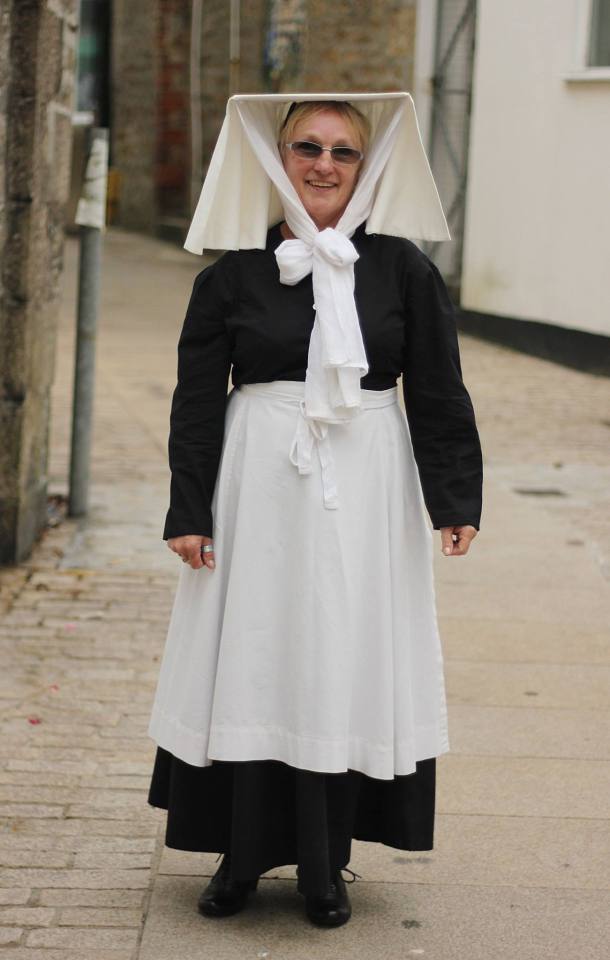
Cornish woman, United Kingdom, by One & All: The Many Faces of Cornwall
#cornish#united kingdom#europe#western europe#folk clothing#traditional clothing#traditional fashion#cultural clothing
177 notes
·
View notes
Text
list of best Universities in Washington State
Washington State is home to many universities and colleges, offering students a wide range of educational opportunities. In this blog post, we’ll provide an overview of some of the top universities in the state.
Antioch University Seattle: Founded in 1975, Antioch University Seattle is a non-profit private higher education institution located in the urban setting of the large city of Seattle…
#Antioch University Seattle#Bastyr University#Bellevue College#Central Washington University#Centralia College#City University of Seattle#Columbia Basin College#Cornish College of the Arts#Eastern Washington University#Gonzaga University#Heritage University#Lake Washington Institute of Technology#list of best Universities in Washington State#Northwest University#Pacific Lutheran University#project topics#Saint Martin&039;s University#Seattle Central College Seattle#Seattle Pacific University#Seattle University#The Evergreen State College#University of Puget Sound#university of washington#Walla Walla University#Washington State University#Western Washington University Whitman College Walla Walla#Whitworth University
0 notes
Text

Oliver The little western engine.
💚he’s about 6’0 and has dark green eyes and is 29 years old.
💚He and toad was saved from scrap by Douglas (his love of his life).
💚He’s Bisexual.
💚He has a Brooklyn accent then a southern accent and now has a Cornish accent.
💚He’s part British and Latin.
💚He can be cocky at times but is very tenacious and obedient.
💚He’s resourceful, Sagacious( very clever) and respectful.
💚Oliver was the one to confess his feelings and his love for Douglas and now the two are soulmates and are in love.
💚He’s a softie about turtles.
💚He’s a hard worker.
💚He likes to cuddle up next to Douglas especially at night.
💚Other than his lover/partner/boyfriend/soulmate Douglas, he’s close friends to Donald, Duck, Sicilia (my oc), Boco, and Edward.
I’m happy with the results of Oliver and hope you’ll like it. I was inspired by @dilemmaverse @asktrio516 that I though what if my own design of Oliver so I’ve now drew my own design of Oliver. 🥰
here’s the ref below



#Ttte#ttte Oliver#oliver the little western engine#sodor magic#charater design#bisexual#ttte humanisation#ttte human au#ttte au#ginjinka#humanized
42 notes
·
View notes
Text
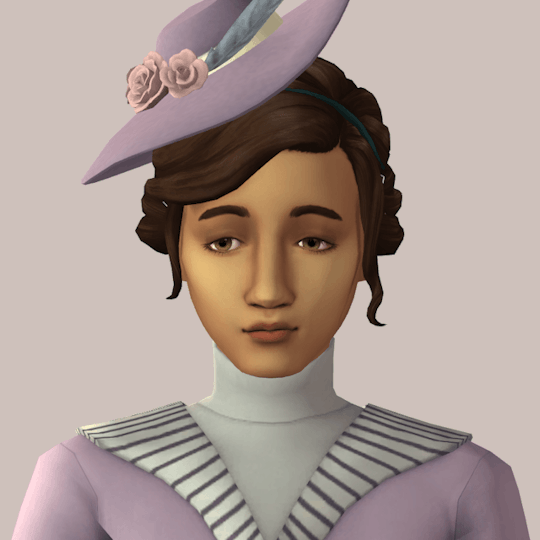

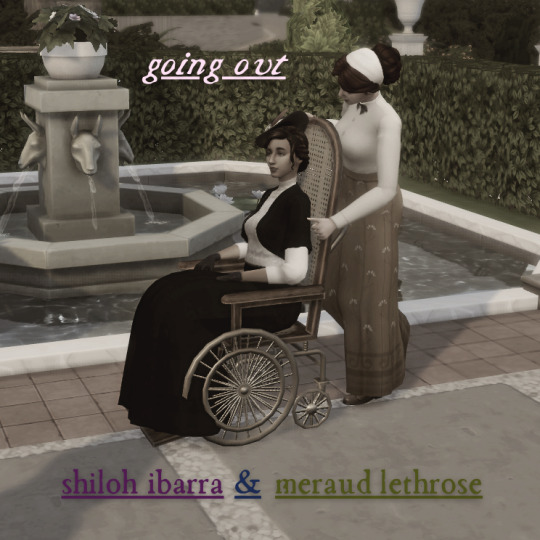

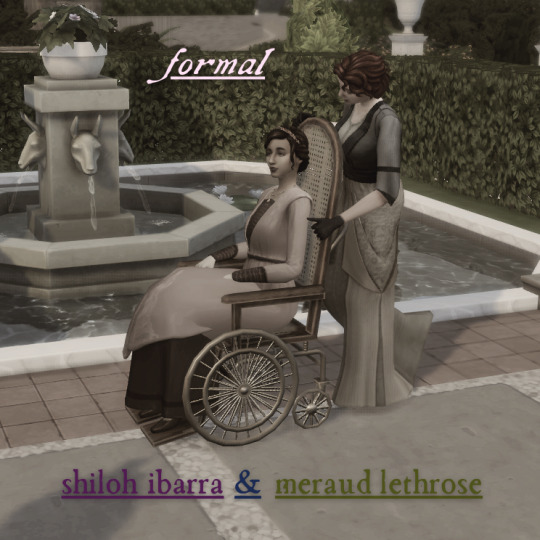


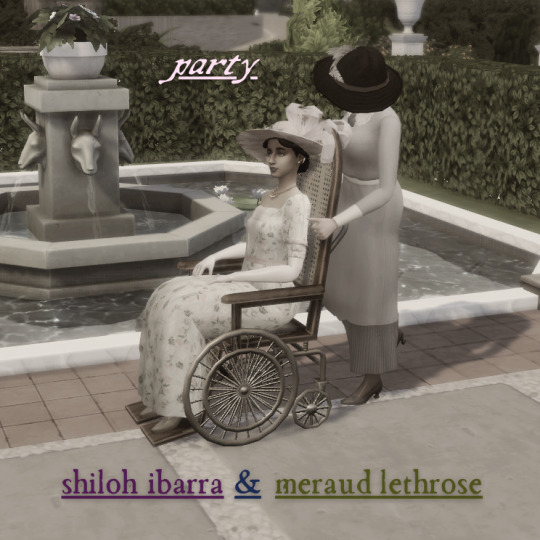
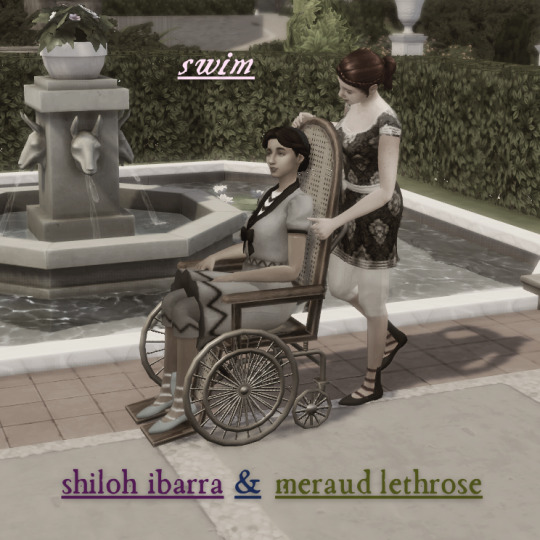
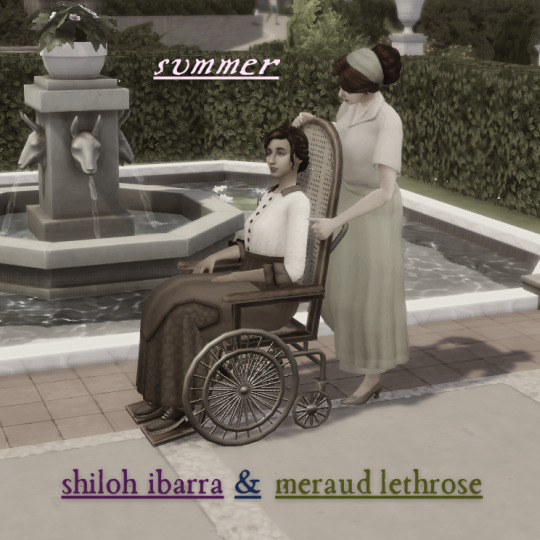


What is beautiful is good and who is good will soon be beautiful. - Sappho of Lesbos
fuck it. higher class english woman from a jewish-italian family and her cornish childhood friend-turned-housemaid that slowly fell in love over the 1910s.
on a more personal note, i don't think i can describe the big old smile on my face when i saw the antique wheelchair from @lilis-palace and the accompanying poses. disability related cc is few and far between, and finding historical disability related cc is like finding a dolphin in the desert. disabled people have always been here, and will always be here.
we've existed throughout history! shanidar one was a neanderthal who had brain damage and possible paralysis, and is estimated to have lived to be between thirty-five and forty-five – pretty old for a neanderthal! disabled people show up often in medieval and biblical texts. the greek god hephaestus is famously described as "lame," "deformed," and/or "impaired". various disabled bodies are portrayed in ancient egyptian art. some people with developmental/learning disabilities were honored by western european courts in the renaissance and believed to be closer to god. closer to the time period portrayed in this post, rosa may billinghurst was known as the "cripple suffragette" and was involved in near constant rallying for women's rights. disabled people are overlooked in studies and perceptions of history for so many reasons; mistreatment, abuse, erasure, eugenics, different ways of categorizing and labelling disabilities, and simply being lost to time and translation. but we've always existed. for every iconic figure of disability history, there's hundreds more who simply existed and had their lives forgotten.
there's names you know like helen keller, frida kahlo, franklin d. roosevelt, and names you don't. if anything i've said at all has interested you, here are a few more notable disabled people from history and modernity to research if you'd like: brad lomex, wilma mankiller, niccolò paganini, ivar the boneless, and barbara jordan.
cc used under the cut! (if it's not linked, it's from the game)
see my resources page!
all/multiple - lilis-palace's antique wheelchair + poses / rheallsim's fancy hairline / mlys' sibel rolled updo / the-melancholy-maiden's edwardian bandeau / citrlet's ivy freckles / plumbobteasociety's fancy fascinator hat / waxesnostalgic's toque hats / blueraptorsden's vintage stockings / satterlly's elizabeth boots / waxesnostalgic's edwardian heel pumps / xldkx-cc's rogue brogues
everyday - linzlu's hattie dress (download link) / sokea-cc's sweater dress
going out - dzifa's holmes dress / dancemachinetrait's priscilla set
wartime - waxesnostalgic's female war worker uniform / waxesnostalgic's v.a.d. headwear / satterlly's v.a.d. nurse uniform
formal - madameriasims4's laurel wreath headpiece / satterlly's silk dress / simlaughlove's alyssum succulents / retro-pixels astor dress
athletic - vintagesimstress's 1897 cycling hat / waxesnostalgic's armistice blouse / waxesnostalgic's female knickerbockers / waxesnostalgic's open collar blouse
sleep - vintagesimstress's 1893 aesthetic dress / sunivaa's lola dress
party - simverses's hat with plume, bow, and roses conversion / historicalsimslife's tea in the garden dress / pinkpatchy's sunless walks hat / twentiethcenturysims' fern dress
swim - linzlu's bathing belle swimsuit / eirflower's bain de soliel bathing shoes / lollaleeloosstuff's historical swimwear
summer - happylifesims' 1910's day dress #1 / waxesnostalgic's open collar blouse (short sleeves) + 1919 skirt (i think) / twentiethcenturysims golden ring accessory
winter - simverse's edwardian tapestry coat conversion / waxesnostalgic's cloche hat / linzlu's florence outerwear (download link)
thank you to @lilis-palace @rheallsim @mlyssimblr @the-melancholy-maiden @citrlet @waxesnostalgic @blueraptorsden @satterlly @xldkx-cc @linzlu @antiquatedplumbobs @sokea-cc @dzifasims @dancemachinetrait @madameriasims4 @simlaughlove @losts4cc @vintagesimstress @sunivaa @simverses @pinkpatchy @twentiethcenturysims @eirflower and @happylifesimsreblogs !!!
#my sims#sims 4 lookbook#ts4 lookbook#s4 historical lookbook#ts4 historical lookbook#ts4 disability#sorry that this turned into like. half an essay. lol.
133 notes
·
View notes
Text
frankly the idea that putting services into english was for "the good of the people" and that medieval people did not understand religion due to the use of latin feels rather insulting; it seems to suggest that the christianity of the (protestant) educated elite was the correct form of worship and that a more popular [in the sense of 'of the people'] form of (at least in medieval and tudor england) catholicism was a wrong of the uneducated that needed to be righted - despite the fact that the average medieval/tudor person would not exactly have been unaware of the religion that pervaded their life. there were other ways to reinforce the messages of christ to an illiterate or monolingual populace beyond translating scripture into english: mystery plays; paintings; preaching; parables; holy days; literature; pilgrimage; and, of course, more. particularly in england this tends to be an aspect of a protestant narrative of history - that protestantism's return to scripture and vernacular bibles would encourage a better, personal understanding of faith, and that being able to understand the bible and communion was for the good of the people. yet if the western rising was anything to go by, many people actually objected to the intrusion of english worship on latin as the liturgical language of the church - part of this may have been due to cornish being the native of language of many of the rebels and therefore making english an incomprehensible intrusion as much as if not more so than latin, but the fact remains that plenty of ostensibly uneducated and illiterate people saw the possibility of worship in a language they understood (the rebellion was centred in cornwall and devon, so many rebels would have spoken english) and rejected it.
the idea of translation and returning to scripture was also not the sole property of protestants - renaissance humanism was the domain of many catholics as well, including the famous erasmus and thomas more, who also saw the virtues of returning to the latin and original greek! the new testament was even translated into english by catholics in 1582 - less than fifty years after the first complete bible in english was published in england, itself hardly renowned for being protestant despite being heavily influenced by william tyndale's translations. one of the problems lies in the fact that henry viii's faith was largely idiosyncratic and doctrinally conservative despite his genuine interest in reform; the second lies in the fact that before the second half of the sixteenth century, catholic and protestant were not coherently defined ideologies or positions, and in fact the words catholic and protestant did not exist. the history of vernacular translations and its relationship with the catholic church and heresy is complicated, but there exist translations of the four gospels as early back as the tenth century; alfred the great ordered the translation of the ten commandments and the laws from exodus; richard rolle translated the psalms into english in the 1340s. the suggestion that the catholic church forbade vernacular translation throughout its history first of all rather misses the point - at the point that the vulgate bible was written, latin was a vernacular language. this is why the latin bible is known as the vulgate - vulgate comes from latin vulgātus, and literally means 'broadcast, published, having been made known among the people[/common]'. it also ties into the idea that the medieval catholic church was a backwards institute which wished to repress... every form of learning? which is obviously false - the catholic church wished to condemn and repress heresy, as it indeed did when john wycliffe produced the wycliffe bible, notorious both for being an early translation of the bible into english and for wycliffe's association with 'proto-protestant' ideas. medieval and catholic are not synoymous with backwards!
insert conclusion here about how patronising it is to assume that all working class english catholics were simply ignorant to the truth and discovering protestantism would instantly make sense to them and how frustrating it is when people conflate commonly held protestant ideals with Things Catholics Never Do. the end
32 notes
·
View notes
Note
Is the reason why it’s commonly repeated in the Witcher fandom that the Witcher is based on Slavic mythology and not European Mythology in general ( a lot particularly from the British isles) is that when it came out in the 90s it was marketed that way due to the cultural Zeitgeist at the time in Poland
Or is it just something that became a thing after the games came out and it was just people in the English speaking world saying “oh it’s from Poland it must be based on their mythology” and Polish fans are fully aware that it has just as much of not more references to the Arthurian legend than it does to Slavic culture
Hey, anon!
I just reblogged something in relation to this, so you might want to check it out (and the several reblogs).
I think if we want to trace the creative influences from the fantasy genre, then it makes no sense to employ umbrella terms with The Witcher. It's Polish fantasy a Polish author with all the particular sensitivities of a Pole wrote. Does the history of CEE inform the writing? Yes, absolutely. Do the cultural attitudes, linguistic peculiarities, and humour? Of course.
Slavic, though? And, moreover, Slavic alone? Well that's a bit preposterous, because Slavic does not designate something "specific" in the first place. I'm a particularist, I'm sorry. And while I am not even a Slav, I can relate to the outlook and "voice" of the characters in The Witcher instantly, because we live in the same neighbourhood. (The neighbourhood has very different corners with equally shitty beaches, you don't usually understand what your neighbour is trying to say to you, and body language can go overbroad just as frequently as overt familiarity is not appreciated.)
Slavic or Celtic or Indo-European or what have you are umbrella terms. They are totalising and their nature overlooks the cultural diversity that the terms draw upon: Celtic, for example, should be divided into insular and continental branches, and the insular Celtic groups, again, could be linguistically divided into Brythonic (Cymraeg/Welsh, Kernewek/Cornish, & Breton) and Gaelic (Gàidhlig/Scottish, Gaeilge/Irish, & Gaelg/Manx). Ditto for Slavic, starting from the East, West, South divide and going more intricate from there.
The lore changes the closer you get with your looking glass. These are not unified categories, even if they are used to generate broad solidarity for good or bad purposes, or to simplify and refer to some broadly received meme (but, for example, your quintessentially Slavic Baba Yaga likely derives from contact with Finno-Ugric and Siberian peoples with their stilt-hut building style, tucked away in the middle of forests, so tell me more about how a legend can "belong" to one people alone).
I guess what we should ask is when and why does it matter who lays claim to these things, and why Slavic? Why not Polish in particular and pan-European in general? I guess it depends on who you are and what you want to do with your statement. Yes, it's that banal.
Because intellectually, when sniffing out the history of its ideas and the flavour of them, The Witcher is incredibly diverse. The author has also been very open about it, referring in detail to a vast amount of literature he has come in contact with in fantasy canon. Generally, that includes authors from Western Europe and Northern America (but his literary influences do not stop with those alone of course) and the thing about, for example, Northern American fantasy is that it has a penchance to romanticize the British Isles (followed close behind by Germanic and Greco-Roman world). It is not without reason that Sapkowski considered Arthuriana the bedrock of Western fantasy - it really was one of the first "medieval fantasies" that was being written and re-written throughout medieval Western Europe already at the time. The PR that memefied the entire enterprise of Arthur and his Brythonic roots has been chugging away for a VERY long time, cross-fertilized by lore from all over the place. But its roots stretch back to the Isles. Because that's where history related to him took place - at the forgotten outpost of the crumbling Roman Empire, which had been colonized before the Romans and would be colonized again after the Romans (and would eventually go on to colonize peoples far and further away from the European peninsula).
The thing is, Arthuriana is like a gateway into the myths of the people among whom he was likely born, and the actual bedrock of various Celtic mythological traditions is much more varied and has a wholly different vibe than the most popular French monks' agendas with Arthur. You could similarly consider Geralt's and Ciri's story a gateway into the folklore and history of the peoples among whom they were brought to life and among whom they first proved popular and "homely"; a signpost leading you into finding out more about the part of the world that birthed them. But CEE, to my knowledge, does not have a fantasy genre tradition with that strong of a PR that would derive from a semi-political legend stretching back a good thousand years, acting as a kind of unifying fairy tale for the various people among whom its figurehead proved popular and drew its tale from. Scratch the figurehead; there just isn't one particular tale as such that would have risen into prominence above all others.
And to split the hair even further, Geralt and Ciri are not semi-historical. Not semi-mythical either, even though Sapkowski tries to lift them into that status by the end of the Pentalogy. They are already composites or subversions of broader fantasy traditions, which have mostly been heavily Western European-centric. The Witcher, however, takes this Western European tradition, traces the roots of its underbelly, and gives its own interpretation. While keeping in spirit intact the lived experience, mentality, and speech of its characters, which are - if you like - the most Slavic features of the tale.
It popularises a lens the like of which there was little of in the Fantasy genre at the time.
(and yes, the games' PR - as a market-oriented enterprise - obviously would try to find the broadest possible common denominator that is still specific enough to ring as novel and sexy in the world-wide market and proud back at home)
#asks#the witcher#the witcher books#wiedźmin#fantasy#polish fantasy#celtic mythology#slavic mythology#eastern europe#the witcher 3#andrzej sapkowski
17 notes
·
View notes
Note
what fae like qualities do you believe aaravos has?
I don't know enough about the fae to say definitively (I've read some works depicting fae, such as The Faerie Queene by Edmund Spenser from the 1500s, A Midsummer Night's Dream by Shakespeare, some other folklore myths) but I try to stay away from sources that are too Christianized for stuff that's more Pagan / northern and western Europe and the 1500s has plenty already.
When in doubt I'm loosely using wikipedia / old class notes for reference but if there's a site or source I think is cool and helpful I'll note it down below.
There is some that are generally common knowledge, such as:
Fae being mischevious tricksters with very particular phrasing. They don't tend to often be outright malevolent as a motivation, but often do harm to humans anyway either due to ignorance or blue-orange morality.
Blue-orange morality (for those who don't want to watch a video) is basically when a creature or being does not have a morality that operates that we would define it (on a spectrum of ethical right or wrong actions per consequence or intention). A good example is the spirits from ATLA (not LOK) or One-One from Infinity Train. He's a helpful little robot guy and he loves his friends, but he is ultimately bound and operates within the Train's rules. It's not that he can't deter from the Train's rules without distress or that he doesn't want to, it's that deterring from the Train's rules just doesn't compute to him as even a thing to do. He's operating on his own unique level and it's what turns him from a S1 ally to a S2 antagonist (but not villain).
There tends to be an emphasis on names, deals, and exchanges, i.e. if a Fae says "Can you give me your name?" and you tell them it, they own it and you by extension now, stuff like that. Also have a tendency to give humans they like, or humans who do nice things for them, gifts (whether it's actually a beneficial gift is sometimes debatable).
The Fae often lure humans away from the Ordinary Realm into the Faerie Realm, where time and magic work differently. Sometimes this means being whisked away, or unknowingly stepping through fairy rings. This can include both the Seelie and the UnSeelie Court (Scottish folklore).
Examples of the Fae in popular culture include Spirited Away (don't eat the food!), changeling myths (faerie leaving their babies in place of your own, nowadays seen as a connection to old stories of Autistic individuals), arguably Coraline (film and book), will-o-the-wisps, and other figures in Welsh, Cornish, and broad European folklore, etc.
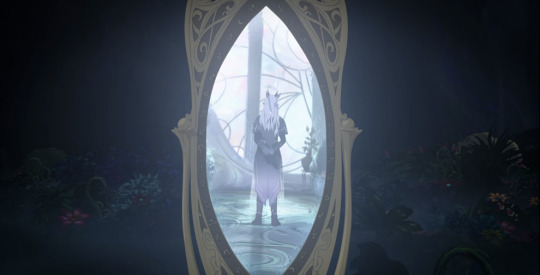
Variants / similarities include huldufolk (Icelandic and Faroese folklore), sirens (Greek), kelpies (Scottish), etc. Over time Christian (bc of course) associations have also been applied as both demoted angels and tempting devils, but that sort of works given one of Aaravos' most prominent comparisons is Lucifer, and Prometheus, who were as crafty and clever as they come.
Basically:
Aaravos emphasis (or lack thereof) regarding his name and the general mystery surrounding it — "My name would mean nothing to you" even in the face of Viren's demands
We see the emphasis on phrasing given that it's been stated by the crew that Aaravos never lies, but we know he purposefully obscures and omits information
Entering into deals and exchanges with humans, giving them gifts and promises (Ziard's staff, Viren's rule for himself and Viren's life for Claudia)
Him seducing Viren yes I said it / everything with Sir Sparklepuff tbh
Fae can also sometimes set trials to pass or tasks for people to fulfil, similar-ish to Aaravos giving Viren a little fetch quest for them to communicate / "Those who fail tests of love are simple animals."
We don't know what Aaravos actually wants, exactly, or why, but given the indifference of the other Startouch elves to humanity's plights (and the fact they've let Aaravos wreak havoc and have never stepped in to stop him) it's a far bet their long, illustrious lives have given them a decidedly warped morality, and that Aaravos is pretty indifferent to other people's immense suffering at this point, too
His mirror realm being its own sort of faerie realm that he can bring Viren in and out of
Aaravos having multiple names and monikers — the Fallen Star, the Midnight Star, one of the Great Ones — much the way the Fae folk have many — the Good Neighbours, the Fair Folk, the Kind Ones, the Wee Folk, the Others (citation).
This isn't as much of a thing but all the nature motifs surrounding Aaravos (Elarion as a flower, the nature-esque patterns on the box that held the Key and that match the key, the flower and vine emulations on his mirror).


#tdp#the dragon prince#aaravos#tdp aaravos#requests#analysis series#analysis#thanks for asking#anonymous#tdp meta
34 notes
·
View notes
Text

It was bound to happen sooner or later: a guest on the BBC’s Antiques Roadshow presented an artefact, which derived from the slave trade – an ivory bangle.
One of the programme’s experts, Ronnie Archer-Morgan, himself a descendant of slaves, said that it was a striking historical artefact but not one that he was willing to value.
‘I do not want to put a price on something that signifies such an awful business,’ he said.
It’s easy to understand how he feels. The idea of people profiting from the artefacts left over from slavery is distasteful.
Yet, as Archer-Morgan said, it is not that the bangle has no value: it has great educational value.
It should be bought by a museum and displayed in order to demonstrate the complex nature of slavery and as a corrective to the narrative that slavery was purely a crime committed by Europeans against Africans.
The bangle was, it seems, once in the possession of a Nigerian slaver who was trading in other Africans.
It’s a reminder that slavery was rife in Africa long before colonial government.
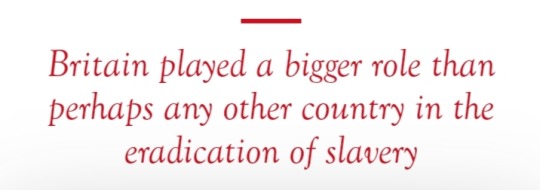
It could also remind us that, though slavery was a global institution, the country that led the world in the rebellion against this barbarism – and played a bigger role than perhaps anyone else in its eradication – was the United Kingdom.
Britain did not invent slavery.
Slaves were kept in Egypt since at least the Old Kingdom period and in China from at least the 7th century AD, followed by Japan and Korea.
It was part of the Islamic world from its beginnings in the 7th century.
Native tribes in North America practised slavery, as did the Aztecs and Incas farther south.
African traders supplied slaves to the Roman empire and to the Arab world. Scottish clan chiefs sold their men to traders.
Barbary pirates from north Africa practised the trade too, seizing around a million white Europeans – including some from Cornish villages – between the 16th and 18th centuries.
It was in fear of such pirates that the song ‘Rule Britannia’ was written: hence the line that ‘Britons never ever ever shall be slaves.’
Even slaves who escaped their masters in the Caribbean went on to take their own slaves.
The most concerted campaign against all this was started by Christian groups in London in the 1770s who eventually recruited William Wilberforce to their campaign, and parliament went on to outlaw the slave trade in 1807.
British sea power was then deployed to stamp it out.
The largely successful British effort to eradicate the transatlantic slave trade did not grow out of any kind of self-interest.
It was driven by moral imperative and at considerable cost to Britain and the Empire.
At its peak, Britain’s battle against the slave trade involved 36 naval ships and cost some 2,000 British lives.
In 1845, the Aberdeen Act expanded the Navy’s mission to intercept Brazilian ships suspected of carrying slaves.
Much is made about how Britain profited from the slave trade, but we tend not to hear about the extraordinary cost of fighting it.
In a 1999 paper, US historians Chaim Kaufmann and Robert Pape estimated that, taking into account the loss of business and trade, suppression of the slave trade cost Britain 1.8 per cent of GDP between 1808 and 1867.
It was, they said, the most expensive piece of moral action in modern history.
The cost of fighting the slave trade cancelled out much, if not all of Britain’s profits from it over the previous century.
There are those who continue to demand reparations for slavery from the UK government and other western powers, yet they rarely, if ever, acknowledge Britain’s role in all but eradicating the evil of the transatlantic slave trade, a cause on which we spent the equivalent of £1.5 billion a year for half a century.
Britain’s role in hastening slavery’s extinction is a remarkable achievement.
It’s astonishing that we have forgotten it almost entirely in the 21st century.
It would be difficult to find anyone in the world whose ancestral tree does not somewhere extend back to a slave-trader.
Huge numbers of us, too, will have been partly descended from slaves.
Britain should not minimise or deny the extent to which it traded slaves to the colonies in the early days of Empire.
But it is also important to remember the thousands who served and died with the West Africa Squadron while seizing 1,600 slave ships and freeing some 150,000 Africans.
We must examine and remember everything about the history of the slave trade, including the forces – moral and military – that eventually brought it to an end.
It’s profoundly worrying that slavery evolved to be a near-universal phenomenon among human societies and inspiring that it came to be all but eradicated within a single human lifespan.
#Britain#slave trade#Antiques Roadshow#Ronnie Archer-Morgan#ivory bangle#artefacts#Rule Britannia#William Wilberforce#Aberdeen Act#slavery#suppression of slave trade#moral action#transatlantic slave trade#BBC
11 notes
·
View notes
Text
Christ is risen; tell everyone!
Orthodox Christians celebrate Easter today. For the next 40 days, we greet each other with the most important news anyone has ever shared
Christ is Risen! Χριστὸς ἀνέστη
and the faithful respond
Truly He is Risen! Ἀληθῶς ἀνέστη!
Abkhazian – Kyrsa Dybzaheit! Itzzabyrgny Dybzaheit!
Afrikaans – Christus het opgestaan! Hy het waarlik opgestaan!
Albanian (Tosk) – Krishti u ngjall! Vërtet u ngjall!
Aleut – Kristus aq ungwektaq! Pichinuq ungwektaq!
Amharic – (Kristos Tenestwal! Bergit Tenestwal!)
Arabic (standard) – المسيح قام! حقا قام! (al-Masīḥ qām! Ḥaqqan qām!) or المسيح قام! بالحقيقة قام! (al-Masīḥ qām! Bi-l-ḥaqīqati qām!)
Armenian – Քրիստոս յարեա՜ւ ի մեռելոց: Օրհնեա՜լ է Յարութիւնն Քրիստոսի: (western dialect: Krisdos haryav i merelotz! Orhnyal e Haroutyunen Krisdosi!) Քրիստոս հարյա՜վ ի մեռելոց: Օրհնյա՜լ է Հարությունը Քրիստոսի: (eastern dialect: Khristos haryav i merelotz! Orhnyal e Harouthyoune Khristosi!) – (Lit: Christ is risen! Blessed is the resurrection of Christ!)
Aromanian – Hristolu unghia! Daleehira unghia!
Azeri – Məsih dirildi! Həqiqətən dirildi!
Basque – Cristo Berbiztua! Benetan Berbiztua!
Belarusian – Хрыстос уваскрос! Сапраўды ўваскрос! (Chrystos uvaskros! Sapraŭdy ŭvaskros!)
Breton – Dassoret eo Krist! E wirionez dassoret eo!
Bulgarian – Христос възкресе! Наистина възкресе! (Hristos vâzkrese! Naistina vâzkrese!) or in Church Slavonic: Христос воскресе! Воистину воскресе! (Hristos voskrese! Voistinu voskrese!)
Carolinian – Lios a melau sefal! Meipung, a mahan sefal!
Catalan – Crist ha ressuscitat! Veritablement ha ressuscitat!
Cebuano – Si Kristo nabanhaw! Matuod nga Siya nabanhaw!
Chamorro – La’la’i i Kristo! Magahet na luma’la’ i Kristo!
Church of England – Alleluia! Christ is Risen! He is risen indeed! Alleluia![3]
Chuvash – Христос чĕрĕлнĕ! Чăн чĕрĕлнĕ! (Khristós chərəlnə! Chæn chərəlnə!)
Coptic (Bohairic) – ΠιχρίςΤος αϥτωΝϥ! ϦΕΝ οΥΜεθΜΗι αϥτωΝϥ! (Pi’Christos aftonf! Khen oumetmi aftonf!)
Cornish – Thew Creest dassorez! En weer thewa dassorez!
Croatian – Krist uskrsnu! Uistinu uskrsnu!
Czech – Kristus vstal z mrtvých! Vpravdě vstal z mrtvých!
Danish – Kristus er opstanden! Sandelig Han er Opstanden!
Dothraki – Khal Asvezhvenanaz yathoay! Me Yathoay Me nem nesa!
Dovahzul – Saviik los alok! Rok los vahzah alok!
Dutch – Christus is opgestaan! Hij is waarlijk opgestaan! (Netherlands) or Christus is verrezen! Hij is waarlijk verrezen! (Belgium)
English – “Christ is risen! Truly, He is risen!” or “Christ is risen! Indeed, He is risen!” or “He [or ‘The LORD’] is risen! He [or ‘The LORD’] is risen indeed!” or “Christ has risen! Indeed, He has!” or “Christ is risen! He is risen, indeed!”
Esperanto – Kristo leviĝis! Vere Li leviĝis!
Estonian – Kristus on üles tõusnud! Tõesti, Ta on üles tõusnud!
Fijian – Na Karisito tucake tale! Io sa tucake tale!
Filipino – Si Kristo ay nabuhay! Totoo, Siya nga ay nabuhay!
Finnish – Kristus nousi kuolleista! Totisesti nousi!
French – Le Christ est ressuscité! En verité il est ressuscité! or Le Christ est ressuscité! Vraiment il est ressuscité!
Frisian – Kristus is opstien! Wis is er opstien!
Galician -Cristo resucitou! De verdade resucitou!
Ganda – Kristo Ajukkide! Kweli Ajukkide!
Georgian – ქრისტე აღსდგა! ჭეშმარიტად აღსდგა! (Kriste aghsdga! Cheshmaritad aghsdga!)
German – Christus (or: Der Herr) ist auferstanden! Er ist wahrhaft (or: wahrhaftig) auferstanden!
Gikuyu – Kristo ni muriuku! Ni muriuku nema!
Greek – Χριστὸς ἀνέστη! Ἀληθῶς ἀνέστη!
Hawaiian – Ua ala aʻe nei ʻo Kristo! Ua ala ʻiʻo nō ʻo Ia!
Hebrew (modern) – המשיח קם! באמת קם! (Hameshiach qam! Be’emet qam!)
Hindustani – येसु मसीह ज़िन्दा हो गया है! हाँ यक़ीनन, वोह ज़िन्दा हो गया है! – یسوع مسیح زندہ ہو گیا ہے! ہاں یقیناً، وہ زندہ ہو گیا ہے! (Yesu Masih zinda ho gaya hai! Haan yaqeenan, woh zinda ho gaya hai!)
Hungarian – Krisztus feltámadt! Valóban feltámadt!
Icelandic – Kristur er upprisinn! Hann er sannarlega upprisinn!
Ido – Kristo riviveskabas! Ya Il rivivesakabas!
Indonesian – Kristus telah bangkit! Dia benar-benar telah bangkit!
Interlingua – Christo ha resurgite! Vermente ille ha resurgite! or Christo ha resurrecte! Vermente ille ha resurrecte!
Irish – Tá Críost éirithe! Go deimhin, tá sé éirithe!
Italian – Cristo è risorto! È veramente risorto!
Japanese – ハリストス復活!実に復活! (Harisutosu fukkatsu! Jitsu ni fukkatsu!)
Kapampangan – Y Cristo sinubli yang mebie! Sinubli ya pin mebie!
Khmer – Preah Christ mean preah choan rous leong vinh! trung mean preah choan rous leong vinh men!
Klingon – Hu’ta’ QISt! Hu’bejta’!
Korean – 그리스도 부활하셨네! 참으로 부활하셨네! (Geuriseudo Buhwalhasheotne! Chameuro Buhwalhasheotne!)
Latin – Christus resurrexit! Resurrexit vere!
Latvian – Kristus (ir) augšāmcēlies! Patiesi viņš ir augšāmcēlies!
Lithuanian – Kristus prisikėlė! Tikrai prisikėlė!
Macedonian
Malagasy – Nitsangana tamin’ny maty i Kristy! Nitsangana marina tokoa izy!
Malayalam – ക്രിസ്തു ഉയിര്ത്തെഴുന്നേറ്റു! തീര്ച്ചയായും ഉയിര്ത്തെഴുന്നേറ്റു! (Christu uyirthezhunnettu! Theerchayayum uyirthezhunnettu!
Maltese – Kristu qam! Huwa qam tassew! or Kristu qam mill-mewt! Huwa qam tassew!
Mandarin – 基督復活了! 他確實復活了! (Jidu fuhuo-le! Ta queshi fuhuo-le!)
Manx – Taw Creest Ereen! Taw Shay Ereen Guhdyne!
Marathi – Yeshu Khrist uthla ahe! Kharokhar uthla ahe!
Middle English – Crist is arisen! Arisen he sothe!
Navajo – Christ daaztsą́ą́dę́ę́ʼ náádiidzáá! Tʼáá aaníí daaztsą́ą́dę́ę́ʼ náádiidzáá!
Neo-Syriac – ܡܫܝܚܐ ܩܡܠܗ! ܒܗܩܘܬܐ ܩܡܠܗ! (Mshikha qimlih! bhāqota qimlih!)
Norwegian Bokmål – Kristus er oppstanden! Han er sannelig oppstanden!
Norwegian Nynorsk – Kristus er oppstaden! Han er sanneleg oppstaden!
Old English – Crist aras! Crist soþlice aras! (Lit: Christ arose! Christ surely arose!)
Old Irish – Asréracht Críst! Asréracht Hé-som co dearb!
Persian – مسیح برخاسته است! به راستی برخاسته است! (Masih barkhaste ast! Be rasti barkhaste ast!)
Polish – Chrystus zmartwychwstał! Prawdziwie zmartwychwstał!
Portuguese – Cristo ressuscitou! Em verdade ressuscitou! or Cristo ressuscitou! Ressuscitou verdadeiramente!
Quechua – Cristo causarimpunña! Ciertopuni causarimpunña!
Quenya – (Hristo Ortane! Anwave Ortanes!)
Rastafarian – Krestos a uprisin! Seen, him a uprisin fe tru!
Romanian – Hristos a înviat! Adevărat a înviat!
Romansh – Cristo es rinaschieu! In varded, el es rinaschieu!
Russian – Христос воскрес! Воистину воскрес! (Christos voskres! Voistinu voskres!)
Rusyn – Хрістос воскрес! Воістину воскрес! (Hristos voskres! Voistynu voskres!)
Sardinian – Cristu est resuscitadu! Aberu est resuscitadu!
Scottish – Tha Crìosd air èiridh! Gu dearbh, tha e air èiridh!
Serbian – Христос васкрсе! Ваистину васкрсе! / Hristos vaskrse! Vaistinu vaskrse! (Christos vaskrse! Vaistinu vaskrse!) or Христос воскресе! Ваистину воскресе! / Hristos voskrese! Vaistinu voskrese! (Christos voskrese! Vaistinu voskrese!)
Sicilian – Cristu arrivisciutu esti! Pibbiru arrivisciutu esti!
Slovak – Kristus vstal z mŕtvych! Skutočne vstal (z mŕtvych)! (although the Church Slavonic version is more often used: Christos voskrese! Voistinu voskrese!)
Slovenian – Kristus je vstal! Zares je vstal!
Spanish – ¡Cristo resucitó! ¡En verdad resucitó!
Swahili – Kristo Amefufukka! Kweli Amefufukka!
Swedish – Kristus är uppstånden! Han är sannerligen uppstånden!
Syriac – ܡܫܝܚܐ ܩܡ! ܫܪܝܪܐܝܬ ܩܡ! (Mshiḥa qām! sharīrāīth qām! or Mshiḥo Qom! Shariroith Qom!)
Tamil – கிறிஸ்து உயிர்த்தெழுந்தார், மெய்யாகவே அவர் உயிர்த்தெழுந்தார்.
The Episcopal Church – Alleluia. Christ is Risen. The Lord is risen indeed. Alleluia.[4]
Tigrigna – (Christos tensiou! Bahake tensiou!)
Tlingit – Xristos Kuxwoo-digoot! Xegaa-kux Kuxwoo-digoot!
Toki Pona – jan sewi Kolisu li tawa tan moli! ni li lon: ona li tawa tan moli!
Traditional (as per Church Slavonic) – Христос воскресе! Навистина воскресе! (Hristos voskrese! Navistina voskrese!)
Turkish – Mesih dirildi! Hakikaten dirildi!
Turoyo-Syriac – ܡܫܝܚܐ ܩܝܡ! ܫܪܥܪܐܝܬ ܩܝܡ! (Mshiḥo qāyem! Shariroith qāyem!)
Tzeltal – Cha’kuxaj Kajwaltik Kristo! Ta melel cha’kuxaj!
Tzotzil – Icha’kuxi Kajvaltik Kristo! Ta melel icha’kuxi!
Ukrainian – Христос воскрес! Воістину воскрес! (Khrystos voskres! Voistynu voskres!)
Uyghur – ئەيسا تىرىلدى! ھەقىقەتىنلا تىرىلدى! (Əysa tirildi! Ⱨəⱪiⱪətinla tirildi!)
Uzbek – Масих тирилди! Хақиқатдан тирилди! (Masih tirildi! Haqiqatdan tirildi!)
Vernacular – Христос воскресна! Навистина воскресна! (Hristos voskresna! Navistina voskresna!)
Vietnamese – Chúa ki-tô đã phục sinh! qu̓a thật ngài đã phục sinh!
Walloon – Li Crist a raviké! Il a raviké podbon!
Waray – Hi Kristo nabanwaw! Matuod nga Hiya nabanhaw!
Welsh – Atgyfododd Crist! Yn wir atgyfododd!
Yupik languages – Xris-tusaq Ung-uixtuq! Iluumun Ung-uixtuq!
72 notes
·
View notes
Text
I really don't think enough English people understand just how ubiquitous the assertion that Cornwall isn't English is amongst Cornish people. Even Cornish people who don't feel strongly about independence will tell you that Cornwall is not in England
At a board games night a trivia question came up that read "What English county is known for its pasties" and every Cornish person in the room without hesitation replied "it's not English". I don't know how they feel about independence, the response is just automatic
Growing up my Cornish mother taught me about the Cornish language and independence movement. She doesn't really care about Cornish independence but it was important to her that I knew about it
Back when I still liked Harry Potter (fuck jkr) I mentioned Professor Trelawny to her and it turned into a lesson about The Song of the Western Men. She told me that in primary school their houses were named after important people from Cornish history (Trelawny, Trevithick, Landor and Davey iirc). Someone once told me that England invented the steam train and my mum immediately responded "No, it was invented by Trevithick" (not sure how you could mistake him for an Englishman when his name was Trevithick)
And it's only ever English people who seem surprised by this. When I told my English flatmates that Cornwall isn't in England they were shocked, but my Welsh flatmates understood it as a given
63 notes
·
View notes
Note
hi fool chicken!!! hope you're having the loveliest of days🫶.
I've seen that you've read Gemma Gary and I was hoping you can help me understand something. I've found connecting with elements and directions and the watchtowers etc really difficult in the past because I didn't even know why are we even using them and giving them random directions but reading Six Ways helped me understand that it gives us a system to work within even if there literally isn't Fire in the South. I really enjoy Gemma Gary's spirits associated with the directions and elements but as i said, it's something i find difficult to connect with, do you have any advice on how can i? like maybe i invoke them with a physical representation and... meditate? and those spirits in her tradition.. they are just based on Cornish lore i believe? (sorry English isn't my first language and i had a TOUGH time reading that book and I'm afraid i didn't understand very much of it). so by my understanding, she assigned these spirits to the directions and elements based on lore and UPG and if i connect with that imagery, i can ask for Hare to help me with connecting to Earth. Even though in other traditions, there are other spirits. and i can invoke the specific spirit i need According to my working or do i need to invoke them all for each, like the hearthside rite? I'm sorry im confused. thank you chicken!!!!!!
Hello,
The concept that the four cardinal directions are not only important, but also have metaphysical elements associated with them, is a belief that is optional to work with.
A lot of ceremonial or ritualistic Traditional Witchcraft do employ the elements and the directions, and it may be difficult to extract your own system of sorcery from that if you want to do TW. However, if you're not super sure that TW is for you, this may be something you don't need to deal with at all.
If you would like to work with elements more, I think what you are describing (meditating upon a physical representation of the element) is a good idea.
I do not know the exact source of Gary's Serpent, Hare, Toad, and Crow. So, I can't confirm or deny your thoughts on how Gary ended up believing in them and their purposes.
Yes, if you want to, you can evoke the White Hare of the Earth in order to aide your workings. You can still do so even if you don't heavily identify with Gary's practices.
You do not need to call every element/direction every time you do every single spell or working.
One way of trying to connect with the four elements is to understand why we even use them. As far as I'm aware (let me know if I'm wrong), it was John Dee's Enochian magic which was the first established Western system that codified the terrestrial world into belonging into four directions, or quadrants, each one associated with a classical element, and each one ruled by an angel.
This idea was developed by the Hermetic Order of the Golden Dawn, who started calling these quadrants Watchtowers.
In Enochian magic and OtGD, each element was associated with one direction, and nobody got to pick or choose which was which. There was one system and everyone did the same thing.
Later on, Gerald Gardner took the concept of the Watchtowers and included it in Wicca, the predecessor of modern Western witchcraft.
As Wicca evolved and inspired many non-Wiccan spiritualities and magical practices, the inclusion of the four elements evolved again. Now, people freely associate elements in the directions that make the most sense to them, based on UPG, and so on.
But even before all of this, the four elements (and aether) were aspects of ancient philosophy: they were ways that people tried to describe the nature of the world around them.
I think that any practitioner who wants to deal with the elements is very well served by understanding how this idea has evolved throughout time.
And I think that starting at the root is very helpful: these concepts are ideas that are supposed to explain and describe the universe around us. Now, we tend to use them metaphysically, not philosophically.
And, just like the modern idea of assigning any elements to any direction, the specific meanings you find within the elements only need to make sense to you. And this includes whether or not you find any value in them at this time, and if they are worth exploring for you.
21 notes
·
View notes
Text

Cornish Montol masker, United Kingdom, by Greg Martin
#cornish#united kingdom#europe#western europe#traditional clothing#traditional fashion#cultural clothing#folk clothing
429 notes
·
View notes
Text
Aboriginal, Gaelic, and Cornish stories about ancient coastal landscape and environmental change on the seashore. Peer-reviewed article documenting impressive age and accuracy of stories, some stories probably thousands of years old, passed on by oral tradition. Specific examples and case studies of stories from Australia and the British Isles. Oral storytelling as a source of historical information. “Literacy,” Euro-American academic hierarchies of knowledge, and the legitimacy and “scientific” accuracy of Indigenous knowledge.
---
In many long-enduring coastal cultures, there are stories – sometimes mythologized – about times when pieces of land became separated from mainlands by submergence, a process that created islands where none existed before. [...] Preserved in oral traditions, memories of land submergence, plausibly attributed to multi-millennial postglacial sea-level rise, are now known from 27 sites along every part of the Australian coast [...]; all traditions are contained in stories repeatedly communicated between generations that recall when the coast was further out to sea, when people utilized the now-submerged land, and where what are now offshore islands were contiguous with the mainland. They include stories about the inundation of Spencer Gulf and the creation of islands therein, including Wardang Island (Waraldi) that became an island 8500–7400 cal BP, an event recalled in various extant Narungga (Aboriginal) stories [...]. Memories of submergence communicated in comparable ways in Haida Gwaii and Heiltsuk (Canada) traditions [...].
---
There is a growing acceptance among scholars of the validity and importance of oral traditions as historical sources, a non-literary archive of stories ‘encoded in ecological, paleontological and archaeological localities’ [...]. Indigenous scholars have been advocating for the inclusion of their ways of knowing in scholarship for decades, calling for the decolonizing of historical methods and the rejection of the perception of oral traditions as an inferior source of knowledge. [...]
---
Acclaimed Lardil storyteller, Dick Roughsey (Goobalathaldin) explained how ‘in the beginning, our home islands, now called the North Wellesleys, were not islands at all; but were part of a peninsula running out from the mainland … the Balumbanda people came along that peninsula long before it was cut up into islands’ (1971, 20). [...]
Many Indigenous groups in South Australia, including the Ngarrindjeri, Ramindjeri and Jarildekald, have told stories about a time when the (now-) offshore island named Kangaroo Island was connected to the mainland [...].
---
There are numerous stories that recall (or can be interpreted as recalling) the effects of sea-level rise [...], particularly off the coast of North Uist [...]. A good example refers to the now-uninhabited Monach (or Heisker) Islands, where its 19th-century residents recounted oral traditions about the time when these islands were contiguous with North Uist. A clue lies in the origin of the name Heisker, from the Gaelic aoi-sgeir meaning isthmus-skerry [...].
Closer to the North Uist mainland is the island of Baleshare where there are legends recalling ‘the walls of ruined cottages … underwater off the western shore’ (James and Duffy 2003, 43). On nearby Kirkibost Island, ‘the sea now occupies fields which formerly produced fine crops of bear or barley’ (MacRae 1845, 163). [...]
A better-documented example refers to the tradition among the people of Berneray and Pabbay Islands, today separated by 3.5 km of ocean, that ‘in former times the two islands were only separated by a very narrow channel, so that people could shout across and be heard, or even throw things across’ (Elton 1938, 287), a story obtained in 1935 from three independent sources. [...]
---
Of interest also are the ways other than storytelling in which memories of islandization were sustained in largely oral contexts. One way was in the names of places, a good example being the alternative name for the Monach Islands (Scotland) as Heisker or aoi-sgeir (isthmus-skerry). Off the south coast of Cornwall (England), the Cornish name for St Michael’s Mount is Carreg Coedh yn Clos, the ‘grey rock in the wood’, which recalls the time when this (now-) island was a hill within a forested part of the mainland (Curran 2000). In northeast Australia, the Aboriginal name mudaga (the pencil pine Athrotaxis cupressoides) refers to a place (now underwater) between Fitzroy Island and the mainland where these trees grew when sea level was lower [...].
---
Where such knowledge could not be written down, it was spoken (and sung or recited or performed) but in colonizers’ worldviews, this was not history but fable, akin to the tales of the Brothers Grimm and Hans Christian Andersen (Mahuika 2019). Western epistemologies divided history into prehistoric (non-literate) and historic (literate), creating a hierarchy with the former deemed inferior. [...]
---
Text by: Patrick Nunn and Margaret Cook. “Island tales: culturally-filtered narratives about island creation through land submergence incorporate millennia-old memories of postglacial sea-level rise.” World Archaeology Volume 54. June 2022. [Bolded emphasis and italicized first paragraph added by me.]
137 notes
·
View notes
Text
and for your ease, here's some photos and descriptions of some of these that you may not be familiar with!

Cornish pasty! this is a little pastry pocket with a meat and veg filling that has PGI status. the traditional and authentic filling is; beef, turnip, potato and onion with salt and pepper, the ingredients make their own gravy inside the pastry case and their original purpose [as with a lot of these pastry held meat and veg dishes; may have been to provide a meal to workers who did manual labour in mines, they could get the pastry dirty and discard it while still enjoying the filling.

the toad in the hole! no toads harmed in the making of this; this is a pancake-esque batter and sausages in a tray that are cut into portions, usually with mash potato or roast potato and gravy! quite often if we made this and had left over batter, we'd make pancakes for dessert, so we liked our batter quite plain; but you can add all sorts of seasonings to it!

proper fish and chips, down south in particular we love it with a curry sauce that's particularly unique to fish and chip shops, it's mild and very thick, similar to a westernized chinese curry sauce [you'll often find mixes for it in stores called 'chip shop curry sauce'] our fish and chips is generally going to be a chunky piece of white fish, cod or haddock but it can be other fish as well, along with chunky hand cut chips that slightly resemble steak fries, but they're much softer. not personally my favorite, but i didn't grow up eating a lot of fish!

lancashire hotpot, this is a stew of lamb and veggies in a rich gravy topped with very thinly sliced potato that turn into little crisps on top, it's fun to eat around a table with family when it's cold, since it's super rich and fatty

the scotch egg! imagine a jammy boiled egg concealed in a meatloaf-esque meatball that's been coated in breadcrumbs and fried, then you have a scotch egg! personally i love to make these fresh and the store bought cold ones just don't compare, they can be fiddly to make right, but they're just very fun things

probably one of our most loved curries in the UK, theres some controversy over who created it, between a chef from glasgow and our large south asian community, but we all agree that it's wonderful and easy to prepare and a great introduction to get fussy kids to try curry

knickerbocker glory is a hilarious name, but really it's just an ice cream sundae rippled with raspberry syrup with fresh fruits, you find them a lot by the seaside! sometimes these sundaes will also have jellies and custards included, but from my experience, vanilla icecream, raspberry syrup, fresh fruit, whipped cream and a cherry on top is the classic

banoffee pie! this is a no bake pie similar to a no bake cheesecake. it's a crumbly biscuit and butter base with layers of toffee sauce, bananas and cream on top, it's very rich and indulgent and always makes a mess

and at request of my US living fiance, his absolute favorite, sticky toffee pudding! this is a hot steamed sponge cake with chopped walnuts and dates with a sticky toffee sauce that's drizzled on top [or sometimes injected into the cake itself] it's incredibly rich and best served with icecream!
#i took so much time writing this out that if anyone decides to be a clown in the notes they're getting blocked#just to get that out of the way#anyway#enjoy foods from the UK that we ACTUALLY eat and not weird stuff that no one really cares about!#also all things i myself have cooked for myself and my family/partner#food images
36 notes
·
View notes
Text
//Just a quick thing, since it's come up a few times recently -
Thera is English.
Cornish to be exact, she's from way down the western end of the country.
But she speaks with an English accent, which makes her sound like a local in England, and out of place elsewhere - depending when and where she is, it might also affect people's responses to her (ie if they have a reason to dislike the English).
8 notes
·
View notes